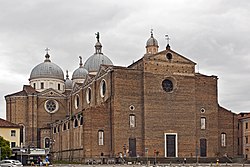Basilica of Santa Giustina, Padua
| Abbazia di Santa Giustina | |

Basilica of St. Justina
|
|
| Monastery information | |
|---|---|
| Order | Order of St. Benedict |
| Established | 10th century |
| Dedicated to | St. Justina of Padua |
| Diocese | Padua |
| Abbot | Francesco Trolese, O.S.B. |
| Architecture | |
| Heritage designation | National monument |
| Site | |
| Coordinates | 45°23′47″N 11°52′47″E / 45.39639°N 11.87972°ECoordinates: 45°23′47″N 11°52′47″E / 45.39639°N 11.87972°E |
The Abbey of Santa Giustina is a Benedictine abbey in the center of the City of Padua, facing the Prato della Valle, which dates from the 10th century. The abbey is attached to the Basilica of Santa Giustina, which was built in the 6th century. Its present shape derives from construction in the 17th century.
The abbey is attached to the basilica which was built in the 520s by the Prefect Opilius to house the remains of St. Justina of Padua (d. 7 October 304) and of other Christian martyrs of the city. The building, with its lavish decorations, was described in 565 in a Life of St. Martin written by Venantius Fortunatus. By the 10th century, the presence of a monastic community which served the many pilgrims who came to the basilica to pray to the saints whose relics were contained there is seen in the decision of the Bishop of Padua in 971 to place the community under the Rule of St. Benedict.
At that point the monastic community undertook renovations of the basilica. In the course of this work, on 2 August 1052 the remains of various saints, including Maximus the Confessor, Felicitas of Padua, Julian the Hospitaller and those identified as the Holy Innocents, were exhumed. In 1110 the abbey was sacked by the troops of the future Holy Roman Emperor Henry V during his invasion of Lombardy, in order to punish the monks for their loyalty to Pope Pascal II. The basilica complex was devastated in 1117 by a very strong earthquake which wreaked havoc throughout northern Italy and Germany. After the basilica and monastery were rebuilt, excavations resumed and in 1174 the remains of the patroness of the abbey was discovered, as were those identified in 1177 as those of Luke the Evangelist.
...
Wikipedia
